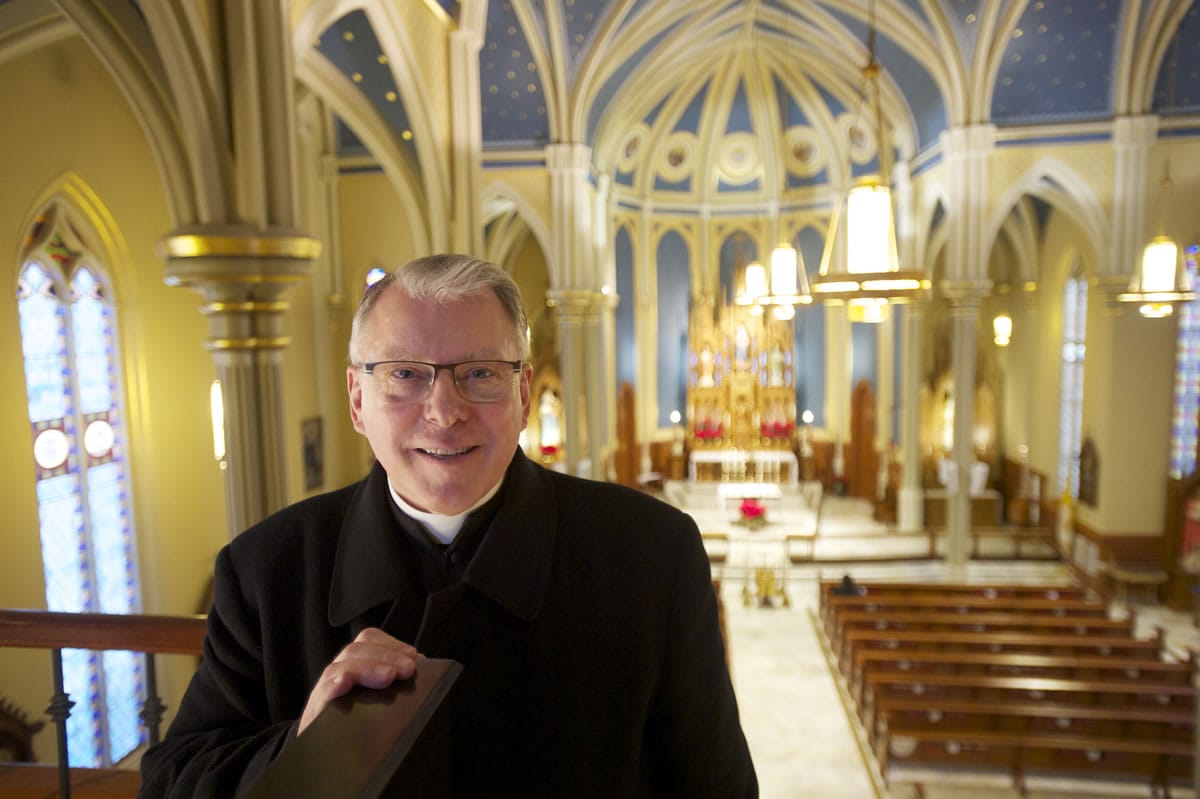The public can see the Proto-Cathedral of St. James the Greater, 218 W. 12th St., without walking into religious services by visiting Tuesdays through Fridays,
8-11 a.m. and 1-4 p.m. Access is through a side door on the west side of the building.
Shaped in part by an Indian massacre and a U.S. Supreme Court ruling, a local church was the hub of Washington’s Catholic ministry for more than 55 years.
The seat of the Nesqually (the original spelling) Diocese was St. James Cathedral, a soaring European-inspired structure in downtown Vancouver.
Until 1903. That’s when Bishop Edward J. O’Dea moved to Seattle. In 1907, the region he oversaw was renamed the Diocese of Seattle, and a new St. James Cathedral was built in the booming Puget Sound city.
And Vancouver’s St. James — the first masonry cathedral in Washington Territory — became a parish church.
It recently received a new designation to recognize its 129 years of history: It has been renamed the Proto-Cathedral of St. James the Greater.
The Rev. William Harris, pastor of St. James, explained the distinctions: A cathedral is the church where the bishop’s chair (“cathedra” in Latin) is located, Harris said.
“A proto-cathedral is simply the first cathedral,” he said: in this case, the church Bishop O’Dea left behind when he moved to Seattle.
When he took over as pastor in July 2012, Harris said he wanted to emphasize the strengths of his parish.
“We don’t have the facilities or the staff or the schools that others have,” Harris said. “We have a historic, beautiful church.”
Its beauty is a combination of Old World artistry and a recent renovation. According to a 1974 account written by Victoria Ransom, the plans for the Gothic Revival cathedral came from Belgium.
The central altarpiece was carved in Belgium in 1884 and shipped to Vancouver around the tip of South America, Ransom wrote in a Fort Vancouver Historical Society journal.
The 2008 renovation included an interior makeover. Sprinkled on the arched ceiling, almost 130 feet above the floor, gold stars twinkle in a deep blue sky.
“It reminds us of heaven, which is our goal,” Harris said.
As far as history goes, the roots of St. James Parish extend a lot further than the proto-cathedral, which opened in 1885. Washington achieved statehood in 1889.
In 1838, the Revs. Francis Blanchet and Modeste Demers were sent here as missionaries by the Archdiocese of Quebec. When they arrived, the British flag waved over this community.
The priests built a wooden St. James Church in 1846 outside the fort stockade on land donated by the Hudson’s Bay Company.
After Father Blanchet was appointed bishop of the Oregon City Diocese, his brother Augustin Blanchet was appointed bishop of a new Walla Walla Diocese.
In 1847, Cayuse Indians killed a Presbyterian missionary and a dozen other whites near Walla Walla in what became known as the Whitman Massacre. That led to a reorganization of the Catholic Church in the Northwest. Bishop Augustin Blanchet was transferred to Vancouver in 1850 to lead a new Nesqually Diocese, and his former diocese in Walla Walla was, in Vatican terminology, suppressed.
That wooden St. James Church outside the Hudson’s Bay stockade became Bishop Augustin Blanchet’s cathedral.
While co-locating in Fort Vancouver with the recently arrived U.S. Army provided Blanchet with a safe location, the site had other issues.
Army ousted mission
According to a heritage marker just north of East Fifth Street and Fort Vancouver Way, the Army established Vancouver Barracks around the Catholic Church’s 640-acre mission claim. An ownership disputed simmered for decades before the Army closed down the mission in 1887 and forced out its inhabitants. (The Supreme Court eventually ruled in favor of the Army in 1895.)
In the meantime, Bishop Blanchet expanded his options. In 1872, the diocese bought a parcel of land in Vancouver, along 12th Street, as a cathedral site.
Blanchet’s successor, Bishop Aegidius Junger, built the cathedral and the first Mass was celebrated in 1885.
O’Dea, the third bishop of Nesqually, ended that line of succession when he moved to Seattle. Now the Vancouver parish’s role in Northwest history has been formalized by the current leader of the Seattle Archdiocese.
Archbishop J. Peter Sartain celebrated Mass in Vancouver on Oct. 25 to officially designate St. James as the proto-cathedral of the Seattle Archdiocese.
Sartain also provided a less-public nod to the church’s past. In a room behind the altar, there still are century-old storage areas marked for the vestments worn by a bishop. They include a compartment for a miter, a bishop’s distinctive headgear.
Harris unlocked the cabinet and opened a box. Sartain has given the proto-cathedral a bishop’s miter.




